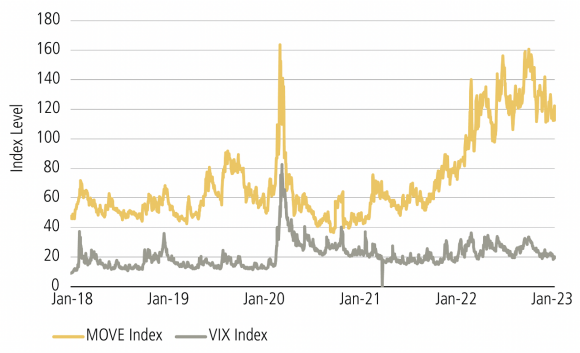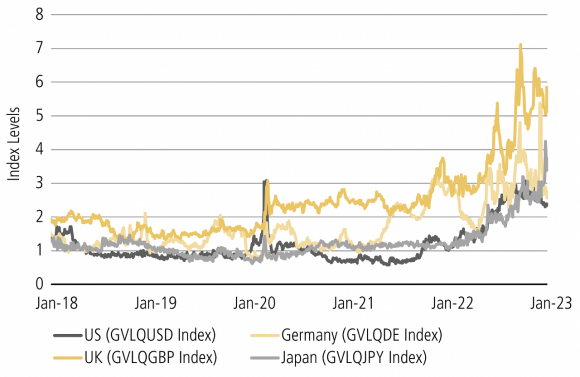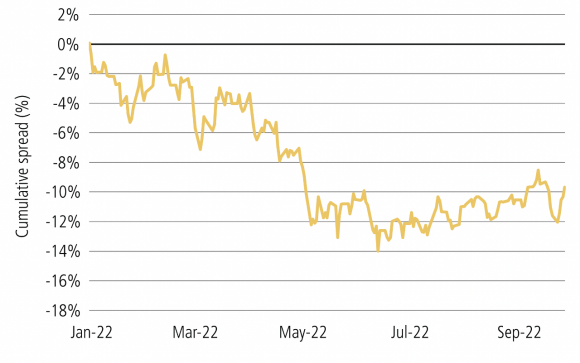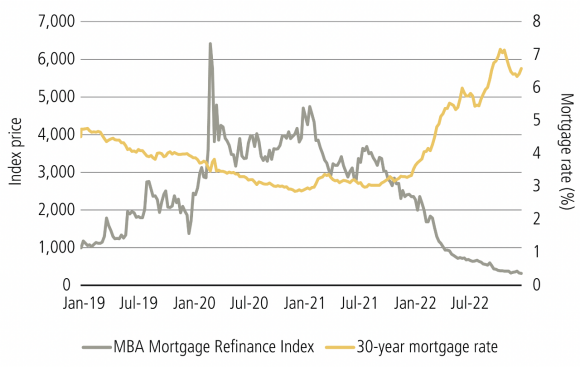
Macro thoughts and portfolio themes
Macro thoughts and portfolio themes
2022 marked the end of the goldilocks era for financial assets and the beginning of a new market regime characterized by higher inflation, decelerating growth, and increased volatility.
In this environment, performance of conventional asset allocations was challenged, particularly as high inflation drove the normally negative correlation between stocks and bonds to turn positive. However, our portfolios were positioned for an inflationary backdrop from the outset of 2022, enabling clients to benefit from the diversification that hedge funds can provide.
In 2022, we were focused on maintaining low beta, and at the core of our portfolios were larger allocations to discretionary macro trading and fixed income relative value (FIRV) – strategies that we believe benefit most from an environment with heightened interest rate volatility. Our commodity exposure contributed positively thanks to sharp trends in the energy complex, particularly natural gas. In Equity Hedged, managers’ long positions were adversely impacted by the macro-driven volatility, but this was generally offset by performance on the short side. Nevertheless, we reduced our overall Equity Hedged allocation and positioned ourselves more defensively by pivoting away from fundamental and event-oriented managers in favor of those with a diversified / market neutral construct and more trading-oriented style. In Credit / Income, we were negatively impacted by exposure to the China property sector, however, we harvested profits from our ABS managers and reallocated capital to long / short corporate credit funds that could profit from widening spreads and increasing dispersion.
As we enter the new year, we struggle to reconcile the view that a soft landing can be achieved with inflation at or below central banks’ targets. Therefore, we remain skeptical of the likelihood of a Fed pivot in 2023. We believe that underneath today’s cyclical disinflationary trends are several structural inflationary factors that have not been fully reflected in forward-looking prices. We expect labor shortages, immigration restrictions, and labor unionization to cause wage inflation that is higher and more stubborn than what the market currently anticipates. For decades, companies have taken advantage of cheaper labor and input costs overseas – making globalization a key disinflationary force. However, we expect geopolitical concerns and a shift from a “just-in-time” to “just-in-case” inventory management approach to reverse this trend. Energy transition policies could continue to generate costly unintended consequences, from resource nationalism to the weaponization of inflation itself, which would also add to upward price pressure. As such, a regime of inflation and “higher-for-longer” interest rates continues to represent our base case.
Portfolio positioning
Portfolio positioning
With this backdrop, our roadmap remains broadly unchanged. We maintain a defensive posturing and overweight strategies that we believe are likely to benefit from higher interest rates and increased volatility.
Our portfolios continue to exhibit a low beta profile and are largely comprised of 1) discretionary macro and fixed income relative value strategies which we believe are well-suited to take advantage of persistent volatility and central bank activities; and 2) low net, liquid equity and credit long / short strategies that seek to monetize dispersion across corporate fundamentals.
Given that the uncertainty around the level of terminal rates has faded, we plan to increase exposure to high quality, uncorrelated carry strategies such as agency mortgages.
We continue to monitor credit markets for more directional opportunities. However, better-than-expected economic resilience, especially in Europe, and limited refinancing needs due to years of low interest rates, have likely extended our timeline for capital deployment in directional Credit / Income sub-strategies.

We maintain a defensive posturing and overweight strategies that we believe are likely to benefit from higher interest rates and increased volatility.
CIO model portfolio and sub-strategy outlook
Strategy | Strategy | Sub-strategy | Sub-strategy | Q1 2023 | Q1 2023 | ||
|---|---|---|---|---|---|---|---|
Strategy |
| Sub-strategy |
| Q1 2023 | Forward looking target weight % | ||
Equity Hedged | Fundamental | - | 12 | ||||
| Equity Event | - | 3 | ||||
| Opportunistic Trading |
| 14 | ||||
| Equity Hedged total |
| 29 | ||||
|
|
|
| ||||
Credit / Income | Distressed |
| 1 | ||||
| Corporate Long / Short |
| 9 | ||||
| Asset Backed Securities |
| 3 | ||||
| Reinsurance / ILS |
| 0 | ||||
| Other Income |
| 2 | ||||
| Credit / Income total |
| 15 | ||||
|
|
|
| ||||
Relative Value | Merger Arbitrage |
| 1 | ||||
| Capital Structure / Volatility Arb |
| 6 | ||||
| Quantitative Equity |
| 5 | ||||
| Fixed Income Relative Value | + | 14 | ||||
| Agency MBS | + | 4 | ||||
| Relative Value total |
| 30 | ||||
|
|
|
| ||||
Trading | Systematic |
| 3 | ||||
| Discretionary |
| 13 | ||||
| Commodities |
| 9 | ||||
| Trading total |
| 25 | ||||
+ Positive Outlook
- Negative Outlook
Equity Hedged
- We continue to remain defensively positioned with our allocation focused on lower net managers. However, we believe that as uncertainty over the health of the economy and the path of interest rates fades, the environment for fundamental and equity event strategies should improve.
- In China, we remain cautious over the medium- to long-term, but have become more constructive over the short-term due to recently instituted accommodative policies.
Fixed income relative value (FIRV)
- We believe that elevated rates volatility, higher yields, and monetary policy normalization will continue to provide a robust opportunity set for FIRV.
Agency MBS
- We plan to increase our allocation to agency MBS which is currently concentrated in residential derivatives. We expect the sub-strategy to provide attractive, uncorrelated carry and to benefit from potential spread tightening as prepayment speeds slow.
Trading
- We expect the opportunity set for global macro strategies to remain robust. Cross market and curve trading opportunities may be more attractive, as well as other directional themes globally, given the varying speeds of central bank policy normalization and continuing economic divergence.
- HFS maintains a positive outlook for Commodities, but we may see a continuation of muted returns over the next few quarters as a bearish macro environment against a structural lack of supply challenges fundamental trading styles in oil and metals.
Strategies
Strategies
Trading
HFS maintains a positive outlook on the discretionary trading strategy as we expect global macro strategies to continue to benefit from a broad opportunity set. Cross market and curve trading opportunities may now be more attractive, as well as other directional themes globally, given the varying speeds of central bank policy normalization and continuing economic divergence. This may also benefit macro relative value styles where mean reversion trades can perform well if rates volatility moderates somewhat from current levels. In emerging markets, idiosyncratic credit selection may be interesting in some high yield markets where there are defined catalysts, such as a restructuring process. HFS maintains a positive outlook for Commodities, but we may see a continuation of muted returns over the next few quarters as a bearish macro environment against a structural lack of supply challenges fundamental trading styles in oil and metals..
Market volatility

Relative Value
Relative Value
In Relative Value, we believe that elevated rates volatility, higher yields, and monetary policy normalization will continue to provide a robust opportunity set for fixed income relative value strategies. Although expected returns may be slightly lower as rate volatility moderates, this may be offset by the benefits of potential curve steepening and quantitative tightening. Elsewhere in Relative Value, our outlook for capital structure / volatility arbitrage remains cautious, although we believe that as the macro environment improves and rate volatility subsides, new issuance levels could increase which would make the opportunity set more attractive. At this juncture, we prefer managers that target shorter duration, lower premium, long convexity convertible arbitrage strategies, or a mix of sub-strategies with low or negative correlation. Lastly, while we continue to hold a positive outlook for quantitative equity strategies, we may reduce our allocation due to the limited capacity in this space and the difficulty in launching new standalone quant funds.
Bond dislocations

Equity Hedged
Equity Hedged
Within Equity Hedged, HFS plans to maintain our exposure. We continue to remain defensively positioned, focusing on lower net managers, particularly within the multi-PM construct, in order to actively limit our equity beta. We believe that as uncertainty over the health of the economy and the path of interest rates fades, microeconomic considerations, rather than macroeconomic factors, should drive the directionality of stock prices and create an environment conducive for alpha generation. In China, we are tactically increasing our exposure over the near-term as we believe that recently instituted pro-growth policies, reversal of Zero-COVID restrictions, and improved technicals should bode well for fundamental investors. However, we remain cautious over the medium- to long-term and therefore, choose to concentrate our exposure to China via tactical and opportunistic managers.
Long positions’ value add vs. SPY

Credit / Income
Credit / Income
For our Credit / Income strategy, we plan to increase our exposure to agency MBS and maintain our allocation to corporate long / short sub-strategies. Within agency MBS, our exposure is concentrated in residential derivatives. We expect the sub-strategy to provide attractive, uncorrelated carry and to benefit from potential spread tightening as prepayment speeds slow. In our view, corporate long / short should be positively impacted by increasing volatility and dispersion as markets grapple with rising rates, deteriorating corporate fundamentals, and a potential recession. Currently, we remain underweight corporate long-biased and distressed, as corporate fundamentals are in the early stages of the credit cycle, and we believe that there will likely be more attractive entry points at wider spreads.
Prepayment speeds and mortgage rates




